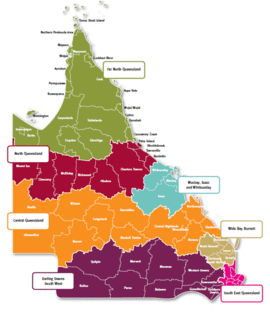
Back South East Queensland German Suda Orienta Kvinslando Esperanto کوئینزلند جنوب شرق Persian Queensland du Sud-Est French サウス・イースト・クイーンズランド Japanese Queensland Tenggara Malay South East Queensland Polish Sudeste de Queensland Portuguese South East Queensland SIMPLE Đông Nam Queensland Vietnamese
| South East Queensland Queensland | |||||||||||||||
|---|---|---|---|---|---|---|---|---|---|---|---|---|---|---|---|
 Regions of Queensland with South East Queensland in the bottom right hand corner of the state | |||||||||||||||
| Population | 3,800,000 (2020)[1][2] | ||||||||||||||
| • Density | 107.8/km2 (279/sq mi) | ||||||||||||||
| Established | 1824 | ||||||||||||||
| Area | 35,248 km2 (13,609.3 sq mi) | ||||||||||||||
| LGA(s) | City of Brisbane, City of Gold Coast, Somerset Region, Sunshine Coast Region, City of Moreton Bay, Redland City, Logan City, Shire of Noosa, Scenic Rim Region, City of Ipswich, Lockyer Valley Region, Toowoomba Region[3] | ||||||||||||||
| |||||||||||||||
South East Queensland (SEQ) is a bio-geographical, metropolitan, political and administrative region of the state of Queensland in Australia, with a population of approximately 3.8 million[2] people out of the state's population of 5.1 million.[1][4][5] The area covered by South East Queensland varies, depending on the definition of the region, though it tends to include Queensland's three largest cities: the capital city Brisbane; the Gold Coast; and the Sunshine Coast. Its most common use is for political purposes, and covers 35,248 square kilometres (13,609 sq mi)[6] and incorporates 11 local government areas,[3] extending 240 kilometres (150 mi) from Noosa in the north to the Gold Coast and New South Wales border in the south (some sources include Tweed Heads, New South Wales which is contiguous as a conurbation with Brisbane/Gold Coast), and 140 kilometres (87 mi) west to Toowoomba (which is simultaneously considered part of the Darling Downs region). It is the third largest urban area in Australia by population.
South East Queensland was the first part of Queensland to be settled and explored by Europeans. Settlements initially arose in the Brisbane and Ipswich areas with activity by European immigrants spreading in all directions from there. Various industries such as timber cutting and agriculture quickly developed at locations around the region from the 1840s onwards. Transport links have been shaped by the range of terrain found in South East Queensland.
The economy of South East Queensland supports and relies on a wide diversity of agricultural manufacturing industries, commerce and tourism. The region has an integrated public transport system, Translink. The gross domestic product is $170 billion.[2]
- ^ a b "Population Estimates by Local Government Area, 2019 to 2020". Australian Bureau of Statistics. 1 March 2021. Retrieved 5 April 2021.
- ^ a b c "Our region at a glance". seqmayors.qld.gov.au.
- ^ a b "SEQ Councils". seqmayors.qld.gov.au.
- ^ Queensland population counter. Queensland Treasury. Retrieved on 27 November 2021.
- ^ Stanton, J. P. (James Peter); Morgan, M. G; University of New England. School of Natural Resources (1977), The rapid selection and appraisal of key and endangered sites : the Queensland case study, the University of New England School of Natural Resources, p. 3, retrieved 11 February 2022
- ^ "South East Queensland. About Us". seqmayors.qld.gov.au.